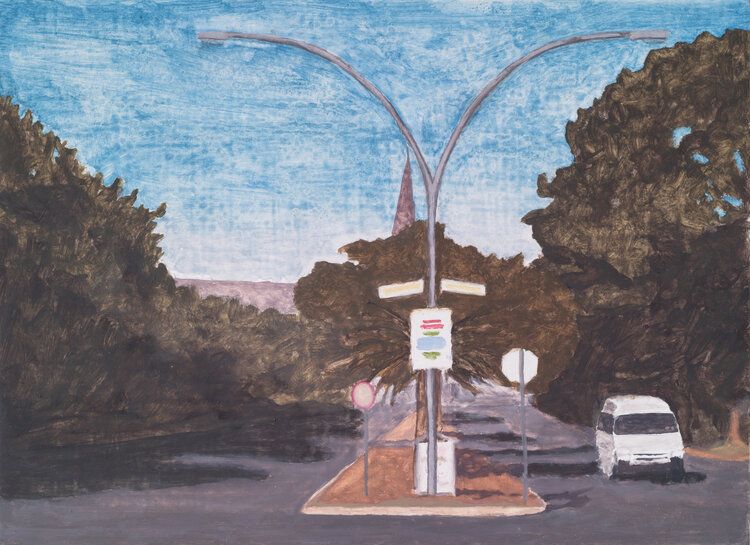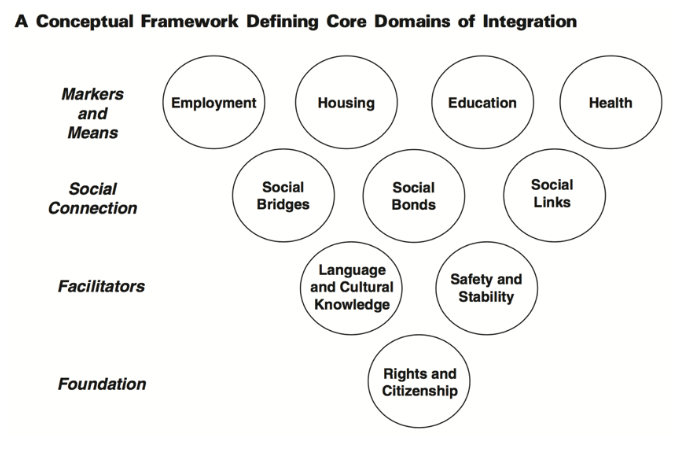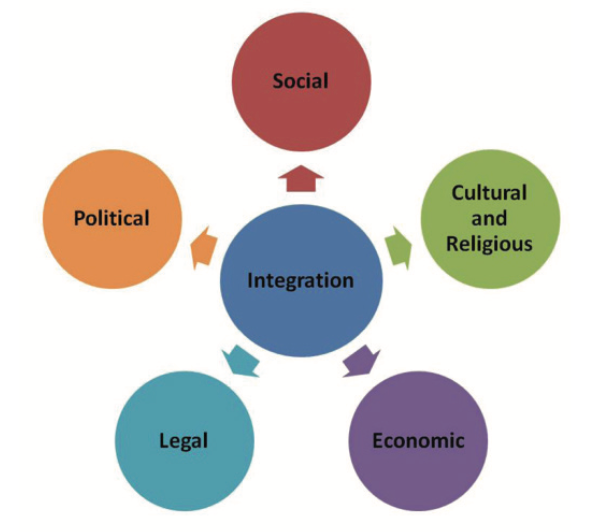Defining Integration

Karen Jacobsen, PhD and Charles M. Simpson, with Marina Lazetić, Jessica Sadye Wolff, Madison Chapman, and Anna Cumming
Dr. Karen Jacobsen is the Henry J. Leir Professor of Global Migration and Principal Investigator of the Refugees in Towns Project.
Charles M. Simpson is a former Visiting Fellow at the Feinstein International Center, Friedman School of Nutrition Science and Policy at Tufts University.
It is widely recognized that the terms “refugee,” “urban,” and “integration,” are not clear-cut or universally defined.[1] There are ongoing debates and inconsistent definitions found in the literature as well as among policymakers and practitioners.
Integration can be defined as a two-way or multidirectional process where both migrant and host populations make changes to incorporate the other. It is different from assimilation, enculturation, and acculturation.
Integration is typically conceptualized encapsulating several domains, which have evolved significantly since the 20th century. At present, there are 13 domains of integration generally cited in the literature.
Defining Integration
The definition of “integration” as it relates to migration is contested and “chaotic,”[2] “however, integration remains significant both as a stated policy goal and as a targeted outcome for projects working with refugees.”[3] While the term is “frequently used in the refugee context, yet [it] ...lacks any formal definition in international refugee law.”[4] From as early as the 1800s, Durkheim defined “social integration” as familial, religious, or moral bonds grown out of a collective consciousness shared by a society and often based on shared rituals[5] – the definition of integration has been debated and evolved ever since.
The question of who is involved in integration is equally loosely defined, although conceptualizations tend to include host and migrant communities, civil society, local, national, and international governments, and Non-Governmental Organizations (NGOs), with the latter three being emphasized in formal resettlement, as opposed to self-settlement, when the former four actors are emphasized.[6]
For the purposes of the literature review upon which this brief is based, “integration” is differentiated from “local integration,” the former being a general process, and the second being a policy prescription, one of the “durable solutions” as defined by the UNHCR and some host governments.[7] This distinction can be described as de jure integration—i.e. integration through formal institutions and processes, sponsored by local, national, and international governments as a “durable solution” as conceptualized by the UN—versus de facto integration that occurs largely through informal systems with tacit acceptance, passive, or active resistance on the part of governments and may be labeled development work, community empowerment, or other related terms by international onlookers.[8]
Differentiating Integration, Assimilation, Enculturation, and Acculturation
The term “integration,” is differentiated from enculturation (“the extent to which individuals adhere to their heritage cultural values and practices”), and acculturation (“the process of adjusting to the influences of two or more cultures”).[9] Integration is also differentiated from assimilation, which is a one-way process where migrant arrivals take on all of the qualities of a host population, while the host population maintains their original conditions without change.[10] Integration, as opposed to assimilation, is a two-way or multidirectional process where both migrant and host populations make changes to incorporate the other.[11]
The Domains of Integration
Integration is typically conceptualized encapsulating several domains. The original 20th century definitions of migrant integration were rudimentary and included only four domains: “the cultural...the normative...the communicative...and the functional...[i.e.] division of labor.”[12] These early conceptualizations had neither clear definitions of each domain, nor measures or indicators for evaluating integration. Some examples of early measure or indicators for these domains included, “attitudes towards displacement,” “ideological-national orientation at exile,” and “host related factors” such as “cultural compatibility,” including “language, values, traditions, religion, politics, food,” “population policies,” and “social receptive- ness.”[13] Throughout the Cold War, the ultimate end goal and the primary mea- sure of integration was attainment of citizenship, at which point integration was considered completed.[14]
By the 1990s, refugee integration research—led by the Chicago school—refocused toward economic integration both as a domain, and a series of measures and indicators.[15] From the 2000s to present, definitions of integration have become more complex and more ordered, building on the greater availability of data and adding more domains, measures, and indicators. Typically, current models of integration include at least six domains. The most widely cited model by Ager and Strang (2008: 170) includes ten domains in four clusters (see Figure 1).

Other researchers, practitioners, and policymakers tend to include at least five of these domains in various combinations. For example, the Global Cities model from Juzwiak, McGregor and Siegel 2014 presents five domains (see Figure 2).

The most commonly used domains in the literature are healthcare, housing, employment, education, and community or social connections,[16] but often researchers will also often include security and political participation as two additional domains.[17]
In sum, the literature review upon which this brief is based found 13 domains of integration:
- Economic: Integration to the local economy, interrelated with “employment,” “livelihoods,” and “assets”
- Social & Communal: Migrants and hosts share groups and networks
- Cultural: Interrelated with social integration: migrants and hosts shared values and culture
- Linguistic: Interrelated with cultural integration, migrants and hosts share languages, and have access to language learning services
- Psychological: Migrants and hosts share ways of thinking about their world, have similar rates of behavioral health symptoms, and have similar psychological coping mechanisms
- Political: Migrants and hosts have similar rights, pathways to citizenship, political representation, and political participation
- Security: Migrants and hosts have similar levels of risk from safety and security hazards, have similar levels of stability, and are equally protected by security institutions
- Informational: Migrants and hosts both have equal access to information about their environment and about each other
- Spatial: Migrants and hosts have equal access to places, overlapping physical use of space, and shared ownership of urban areas
- Housing: Migrants and hosts share and have equal access to the housing stock of an urban space
- Infrastructural: Migrants and hosts both have equal access and use of urban infrastructures such as public transit, water, or electricity
- Educational: Levels of educational attainment are comparable between migrants and hosts, and both have equal access to educational services
- Health: Health indicators are comparable between migrants and hosts, and both groups have equal access to healthcare services
Jacobsen, Karen and Charles M. Simpson. Leir Briefing Room: Defining Integration. Medford: Leir Institute for Migration and Human Security, 2023. https://leir-briefing-room.ghost.io/defining-integration/
Footnotes:
- Council of Europe 2000
- Robinson 1998: 118
- Ager and Strang 2008
- Crisp 2004: 1-2
- Emile Durkheim
- Crisp 2004: 1-2, Jacobsen 2001: 2
- Fielden 2008, Hovil 2014, UNHCR 2004
- Hovil 2014, Jacobsen 2001, Kaiser 2005
- David 2013: 124-125, see also Berry 1994, Phillimore and Goodson 2008, Young 1996
- David 2013: 124-125
- Ager & Strang 2008. See “The Process of Integration” document for more discussion.
- Landecker 1951
- Kunz 1981
- Crisp 2004, Hovil 2014, Jacobsen 2001
- Ott 2013
- Schibel et al. 2002: 5
- Stanley 2003: 12
